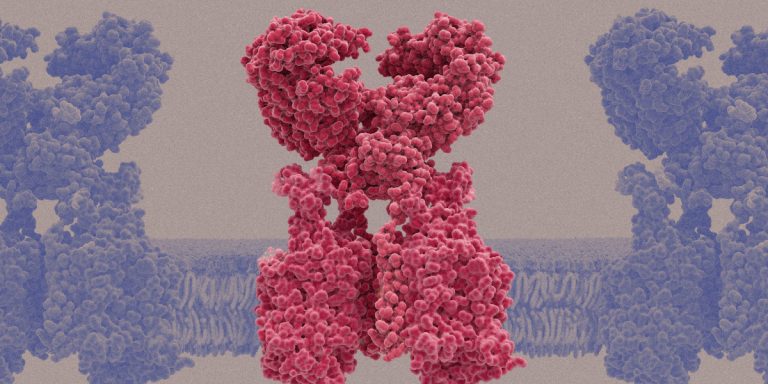
As covid-19 continues to evolve in the US, researchers are actually creating the subsequent technology of therapeutics, together with a brand new strategy that might assist cut back the time it takes to get better from the illness.
Whereas current remedies embrace antivirals, antibodies, and steroids, scientists in the US and Europe are actually specializing in creating decoys of the receptors the virus usually binds to, probably neutralizing its dangerous results.
To develop the new remedy, scientists first needed to engineer mice with a variant of the human protein referred to as angiotensin-converting enzyme 2, or ACE2. This resides on the floor of cells and helps regulate phenomena similar to therapeutic, irritation, and blood stress.
Whereas ACE2 receptors might be discovered on cells throughout the physique, they’re particularly prevalent inside the lungs, coronary heart, kidneys, and liver—organs the illness usually assaults.
To guard the actual ACE2 receptors, right here’s how the decoy does its job:
Normally, spike proteins on the virus’s floor act like keys to ACE2 receptors, opening up the doorway to an infection. However the decoys, administered intravenously or via the nostril relying on the stage of the illness, intercept the spike protein, main it away from actual receptors. After an infection, the remedy may cut back the viral load inside the physique, which could imply quicker restoration instances for sufferers.
In a single examine led by Daniel Batlle, a professor of medication at Northwestern College, mice that have been contaminated with the illness and acquired the remedy had solely delicate signs in contrast with animals that went untreated, which died.
As of right this moment, just one scientific trial of the ACE2 product has been accomplished in sufferers with reasonable to extreme signs. Even so, increasingly more researchers are supporting the new therapeutic.
Batlle’s workforce started engaged on decoy proteins in January 2020 after studying about the first US case, constructing on data gleaned from China’s 2003 SARS-CoV outbreak.
“We knew that it might be very doubtless that the receptor for SARS-CoV-2 could be ACE2, because it had been beforehand proven to be the case for SARS-CoV,” Batlle says.
However making use of that data wasn’t so simple. Michael Jewett, a professor of chemical engineering at Northwestern College who was not concerned in the examine, compares the intricate course of of creating a decoy to an particularly fiendish puzzle.
“Reengineering advanced organic methods might be tough,” Jewett says. “It’s sort of like fixing a puzzle and each time you put one piece in, the remainder of the puzzle modifications.”
Jewett additionally says that in contrast with antibody remedies, decoys needs to be decrease in price and simpler to make use of. And a few specialists are optimistic about the decoy’s capability to chase away each the authentic viral pressure and mutations to return.
In one other examine, utilizing a course of known as deep mutational scanning, Erik Procko, a professor of biochemistry at the College of Illinois Urbana-Champaign, was in a position to view 1000’s of various ACE2 mutations in a single experiment and see which of them may higher entice and bind to the virus. Then his workforce constructed decoys mimicking the ones that carried out finest. The decoys don’t connect to cells however float in the fluid between them to catch the virus earlier than it binds to the actual ACE2 receptors.
Through the use of a mix of three mutations, his workforce was in a position to significantly improve the decoy’s affinity for covid-19. They created decoy receptors that certain to the virus 50 instances extra strongly than ACE2.
To check the strategy, Procko’s workforce used human tissue as a substitute of dwell animals. “In in vitro tissue tradition, we all know that a few of the decoy receptors are simply as potent—generally just a little higher, generally rather less so, however total simply as potent—as monoclonal antibodies which have emergency-use authorization or are in scientific trials,” says Procko.
One concern was that considered one of these mutations may permit for so-called viral escape and assist shore up the virus’s resistance to remedy. However as a result of the decoys intently resemble pure receptors, says Procko, the virus isn’t more likely to evolve unnaturally on account of their motion.
Due to variations in infrastructure and schooling, entry to synthetic-biology applied sciences is unequally distributed worldwide. Extra analysis—and extra funding—is required earlier than such a remedy might be publicly obtainable. However advances like these might finally assist create low-cost, transportable, easy-to-use remedies for the illness.
“There are promising indicators that decoys that very intently resemble the human ACE2 receptor might be potent and efficacious in opposition to all of those new variants,” Procko says. “I wouldn’t be stunned if we had a few of these next-generation decoys reaching the clinic inside a few years.”